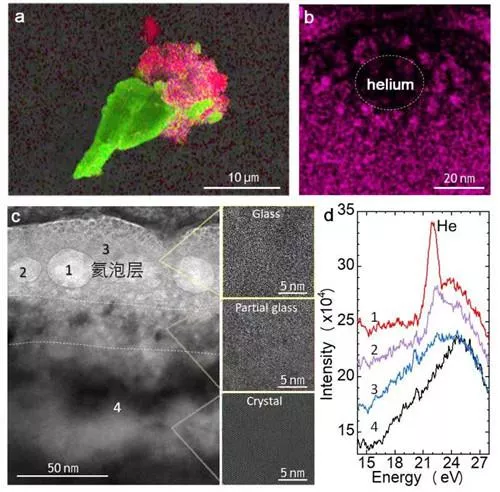Recently, a joint team from Ningbo Institute of materials technology and engineering, Chinese Academy of Sciences, qianxuesen laboratory, Institute of physics, Chinese Academy of Sciences and Nanjing University has detected and studied helium atoms in Chang'e 5 lunar soil particles. It is found that there is a layer of amorphous glass on the surface of ilmenite particles in lunar soil.
Researchers observed a large number of helium bubbles in the glass layer, about 5 ~ 25nm in diameter, and most of the bubbles were located near the interface between the glass layer and the crystal. However, there are almost no helium bubbles in the crystals inside the particles. In view of the high solubility of helium in ilmenite, researchers believe that helium atoms are first injected into ilmenite lattice by solar wind, and then helium will be gradually released under the channel diffusion effect of lattice. The surface glass has a disordered atomic stacking structure, which limits the release of helium atoms. It is captured and gradually stored, forming bubbles.

As an isotope of helium, helium-3 has important application value in energy, scientific research and other fields. The energy generated by 100 tons of helium-3 nuclear fusion can be supplied to the world for one year, and the helium-3 nuclear fusion process is cleaner and more controllable without the risk of neutron secondary radiation. In addition, helium-3 is the key refrigerant to obtain extremely low temperature environment, and is a necessary material in the frontier research fields such as superconductivity, quantum computing, topological insulator and so on. However, the helium element on the earth is mainly helium-4, and the helium-3 reserve is only about 0.5 tons, which is far from meeting the existing demand.
Helium-3 is an important component of the solar wind. The moon has stored a large amount of helium-3 due to its perennial exposure to the solar wind. But why is the moon rich in strategic helium-3? In what form is helium-3 stored on the moon? There are no clear answers to these questions. Exploring lunar resources, especially the content, distribution and exploitation of helium-3, has become the inevitable trend and main task of international deep space exploration. Previous studies have shown that helium-3 is dissolved in lunar soil particles, and the extraction of helium-3 is limited by the diffusion rate, requiring a high temperature of more than 700 ℃, which is not only high energy consumption, but also slow, which is not conducive to in-situ mining on the moon.
The latest research of the scientific research team shows that it is possible to extract helium-3 stored in the form of bubbles at room temperature through mechanical crushing, without heating to high temperature. Moreover, ilmenite has weak magnetism and can be separated from other lunar soil particles through magnetic screening, which is convenient for in-situ mining on the moon. According to the estimation of the total amount of ilmenite on the moon, the total amount of helium-3 stored in the form of bubbles may be as high as 260000 tons. If all of it is used for nuclear fusion, it can meet the global energy demand for 2600 years. These results not only provide new insights into the enrichment mechanism of helium-3 on the moon, but also lay a theoretical foundation for the future in-situ exploitation and utilization of helium-3 on the moon, which is of great significance to explore the effective utilization path of lunar resources.